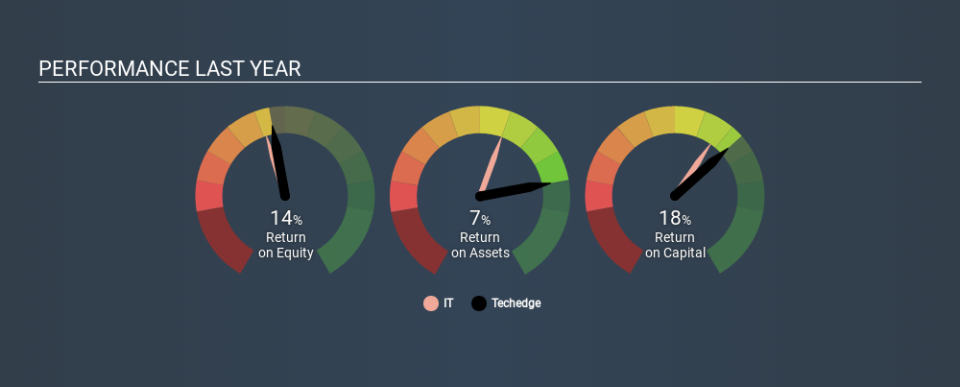Why Techedge S.p.A.’s (BIT:EDGE) Return On Capital Employed Is Impressive

Today we'll look at Techedge S.p.A. (BIT:EDGE) and reflect on its potential as an investment. To be precise, we'll consider its Return On Capital Employed (ROCE), as that will inform our view of the quality of the business.
First up, we'll look at what ROCE is and how we calculate it. Second, we'll look at its ROCE compared to similar companies. Then we'll determine how its current liabilities are affecting its ROCE.
Return On Capital Employed (ROCE): What is it?
ROCE measures the amount of pre-tax profits a company can generate from the capital employed in its business. In general, businesses with a higher ROCE are usually better quality. Overall, it is a valuable metric that has its flaws. Renowned investment researcher Michael Mauboussin has suggested that a high ROCE can indicate that 'one dollar invested in the company generates value of more than one dollar'.
So, How Do We Calculate ROCE?
Analysts use this formula to calculate return on capital employed:
Return on Capital Employed = Earnings Before Interest and Tax (EBIT) ÷ (Total Assets - Current Liabilities)
Or for Techedge:
0.18 = €18m ÷ (€163m - €60m) (Based on the trailing twelve months to June 2019.)
So, Techedge has an ROCE of 18%.
See our latest analysis for Techedge
Is Techedge's ROCE Good?
ROCE can be useful when making comparisons, such as between similar companies. In our analysis, Techedge's ROCE is meaningfully higher than the 12% average in the IT industry. We would consider this a positive, as it suggests it is using capital more effectively than other similar companies. Independently of how Techedge compares to its industry, its ROCE in absolute terms appears decent, and the company may be worthy of closer investigation.
You can see in the image below how Techedge's ROCE compares to its industry. Click to see more on past growth.
When considering this metric, keep in mind that it is backwards looking, and not necessarily predictive. ROCE can be deceptive for cyclical businesses, as returns can look incredible in boom times, and terribly low in downturns. ROCE is only a point-in-time measure. Future performance is what matters, and you can see analyst predictions in our free report on analyst forecasts for the company.
Techedge's Current Liabilities And Their Impact On Its ROCE
Current liabilities include invoices, such as supplier payments, short-term debt, or a tax bill, that need to be paid within 12 months. Due to the way the ROCE equation works, having large bills due in the near term can make it look as though a company has less capital employed, and thus a higher ROCE than usual. To check the impact of this, we calculate if a company has high current liabilities relative to its total assets.
Techedge has total liabilities of €60m and total assets of €163m. As a result, its current liabilities are equal to approximately 37% of its total assets. Techedge has a medium level of current liabilities, which would boost the ROCE.
The Bottom Line On Techedge's ROCE
Techedge's ROCE does look good, but the level of current liabilities also contribute to that. There might be better investments than Techedge out there, but you will have to work hard to find them . These promising businesses with rapidly growing earnings might be right up your alley.
There are plenty of other companies that have insiders buying up shares. You probably do not want to miss this free list of growing companies that insiders are buying.
If you spot an error that warrants correction, please contact the editor at editorial-team@simplywallst.com. This article by Simply Wall St is general in nature. It does not constitute a recommendation to buy or sell any stock, and does not take account of your objectives, or your financial situation. Simply Wall St has no position in the stocks mentioned.
We aim to bring you long-term focused research analysis driven by fundamental data. Note that our analysis may not factor in the latest price-sensitive company announcements or qualitative material. Thank you for reading.


